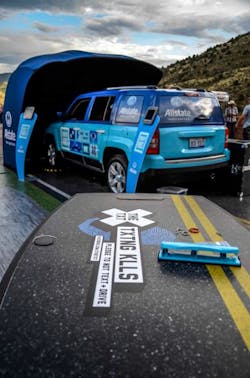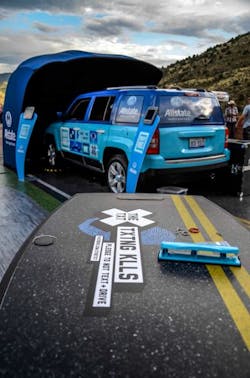The firm’s “Reality Rides” simulator will tour 25 American cities starting with the Denver Auto Show this week and continuing on to visit a range of community gatherings and sporting events as well as participating in select teen safe driving advocacy programs across the country.
The “Reality Rides” simulator uses virtual reality technology built into a real but stationary car equipped to display what Allstate calls a “responsive animated environment” on a curved light emitting diode (LED) television embedded in the windshield.
Using the steering wheel, throttle and brake pedals just like they would do in a real vehicle, operators attempt to drive while trying to text, talk on the phone and enter navigation system directions simultaneously.
If participants “crash” the vehicle due to being distracted, they are issued “traffic tickets” that detail the potential penalties they’d receive if those simulated scenarios occurred in real life.
“More than a decade ago, we began to build awareness of how distractions in the car could become driving dangers,” noted Steve Sorenson, Allstate’s executive VP of product operations, in a statement. “Today, our Reality Rides simulator provides an impactful way for drivers to learn firsthand how significantly distractions can affect their ability to drive safely.”
Allstate noted that more than 3,000 lives are lost and 400,000 people are injured as a result of distracted driving annually, according to data compiled by the National Highway Traffic Safety Administration (NHTSA), which is the main reason why the firm said it’s put the “Reality Rides” simulator on a nationwide tour for the past three years.The insurance company also highlighted some other scary data regarding the dangers of distracted driving:
- Distracted driving is attributed to about 16% of all car collisions.
- Studies have shown drivers who text are 23 times more likely to crash, and texting while driving is the equivalent to driving impaired after drinking four beers.
- Car crashes are the number one cause of death for everyone in the U.S. aged 11 to 27, with teens crashing four times more often than any other age group.
- Stronger teen driving laws, referred to as Graduated Driver Licensing (GDL), have been shown to reduce traffic fatalities by as much as 30% in the states where they have been adopted.
- Research from The Allstate Foundation's "License to Save" report found that comprehensive GDL laws could save an estimated 2,000 lives and $13.6 billion annually.
Allstate also noted that it’s conducted surveys of more than 4,500 people who experienced the “Reality Rides” simulator to gauge how it’s helped raise awareness regarding the perils of distracted driving.
Those polls involved participants in 70 “Reality Rides events aged 15 and older from April 2013 through November of 2014.
Interestingly, most of those polled admit that despite being aware of the dangers posed by texting or talking on the phone while driving, they do so anyway:
- A large majority (85%) think texting and distracted driving is the same or more dangerous than drunk driving.
- Yet nearly 60% admit to talking on the phone and 43% admit to texting while driving at least "sometimes" if not more.
- Nearly seven-in-10 rate their ability to text or talk on the phone while driving as "fair" or "poor" as opposed to "the same," "good" or "excellent."
After experiencing the Reality Rides simulation, participants answered another survey that gauged its reach in changing their road safety opinions:
- Six-in-10 said they would "never text and drive," and another nearly one-third said they would "think twice about texting while driving."
- A majority of participants (58%) said they will not let others drive distracted or they will inform others of the dangers (almost 35%).
- A vast majority – 92% – said they are less likely to ride with others who text or are distracted while driving.
Ultimately, though, will such simulated experiences change driver behaviors out on the road? That’s the hope of course. But as anyone who’s ever tried to break a bad habit, it’s far easier to talk about it than actually do it.
Hopefully, though, where distracted driving is concerned, that won’t be the case.


